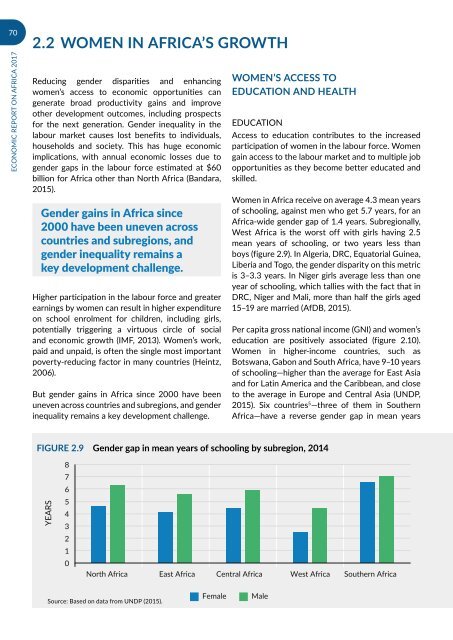URBANIZATION AND INDUSTRIALIZATION
Economic%20Report%20on%20Africa%202017%20UNECA
Economic%20Report%20on%20Africa%202017%20UNECA
Create successful ePaper yourself
Turn your PDF publications into a flip-book with our unique Google optimized e-Paper software.
70<br />
ECONOMIC REPORT ON AFRICA 2017<br />
2.2 WOMEN IN AFRICA’S GROWTH<br />
Reducing gender disparities and enhancing<br />
women’s access to economic opportunities can<br />
generate broad productivity gains and improve<br />
other development outcomes, including prospects<br />
for the next generation. Gender inequality in the<br />
labour market causes lost benefits to individuals,<br />
households and society. This has huge economic<br />
implications, with annual economic losses due to<br />
gender gaps in the labour force estimated at $60<br />
billion for Africa other than North Africa (Bandara,<br />
2015).<br />
Gender gains in Africa since<br />
2000 have been uneven across<br />
countries and subregions, and<br />
gender inequality remains a<br />
key development challenge.<br />
Higher participation in the labour force and greater<br />
earnings by women can result in higher expenditure<br />
on school enrolment for children, including girls,<br />
potentially triggering a virtuous circle of social<br />
and economic growth (IMF, 2013). Women’s work,<br />
paid and unpaid, is often the single most important<br />
poverty-reducing factor in many countries (Heintz,<br />
2006).<br />
But gender gains in Africa since 2000 have been<br />
uneven across countries and subregions, and gender<br />
inequality remains a key development challenge.<br />
WOMEN’S ACCESS TO<br />
EDUCATION <strong>AND</strong> HEALTH<br />
EDUCATION<br />
Access to education contributes to the increased<br />
participation of women in the labour force. Women<br />
gain access to the labour market and to multiple job<br />
opportunities as they become better educated and<br />
skilled.<br />
Women in Africa receive on average 4.3 mean years<br />
of schooling, against men who get 5.7 years, for an<br />
Africa-wide gender gap of 1.4 years. Subregionally,<br />
West Africa is the worst off with girls having 2.5<br />
mean years of schooling, or two years less than<br />
boys (figure 2.9). In Algeria, DRC, Equatorial Guinea,<br />
Liberia and Togo, the gender disparity on this metric<br />
is 3–3.3 years. In Niger girls average less than one<br />
year of schooling, which tallies with the fact that in<br />
DRC, Niger and Mali, more than half the girls aged<br />
15–19 are married (AfDB, 2015).<br />
Per capita gross national income (GNI) and women’s<br />
education are positively associated (figure 2.10).<br />
Women in higher-income countries, such as<br />
Botswana, Gabon and South Africa, have 9–10 years<br />
of schooling—higher than the average for East Asia<br />
and for Latin America and the Caribbean, and close<br />
to the average in Europe and Central Asia (UNDP,<br />
2015). Six countries 5 —three of them in Southern<br />
Africa—have a reverse gender gap in mean years<br />
Figure 2.9 Gender gap in mean years of schooling by subregion, 2014<br />
YEARS<br />
8<br />
7<br />
6<br />
5<br />
4<br />
3<br />
2<br />
1<br />
0<br />
North Africa East Africa Central Africa West Africa Southern Africa<br />
Source: Based on data from UNDP (2015).<br />
Female<br />
Male


